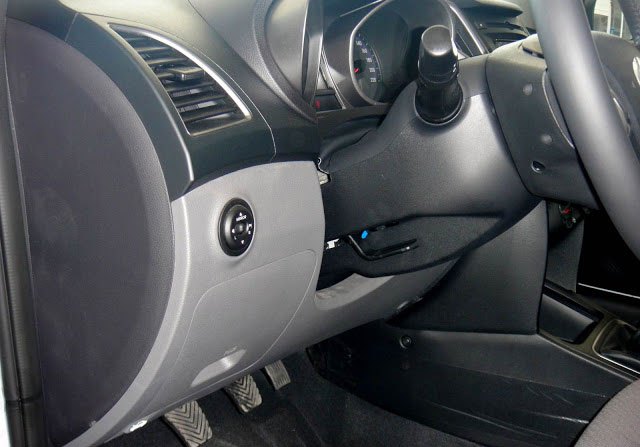Hyundai HB20, Brazilian Spec: Here She Comes Now Singing Moanie Moanie

The fluidic design of the HB20 has impressed Brazilians greatly. The car has already broken into the top 10, and Hyundai claims there are 24 thousand people who have already ordered one and have plunked down some money. Undeniably, the car is a looker. In my opinion, the side is the highlight. That swoosh is very appealing. As for the front, you either like the corporate mug or you don’t, and I don’t. The back has some problems. This is a problem in Brazil. We are into backs. This one makes the car look narrower and taller than it really is and some of the lines are clashing. In general, the car is well-built, but it’s not perfect. The example I drove had misaligned doors.
Inside, Hyundai promised that the HB20 would be competitive with higher segment cars. At first glance it is. The shapes and some color are there. However, after a more tha perfunctory glance, the plastics reveal themselves. They are hard and look cheap. They’re no fun to touch, either.
The seats are ok, but the fabric on them is cheaper than on competitors and even on lesser cars. The switchgear is not a notch above the competition, as Hyundai has claimed. Those found in a Volkswagen Gol, for example, feel more solid.
I had been to the dealer. I had sat in a few. Finally, I got to drive it. Equipped with the same 120 hp present in other Hyundai-Kia products and a 5 speed manual, the car never felt specially lively or obedient. The steering lacks almost any feel and I felt it was quite tiring for anything but city driving. Push the car over 90 km/h (56 mph) and it gets so light that I didn’t feel I wanted more.
The car does not want to be pushed. It creaks. It shakes. It moans. Moans. The suspension arms are too short for Brazil, and it reaches its limit (with a thud) at almost every speed bump at almost any speed. Minor potholes turn into major problems. In the twisties the car feelks like it wants to roll over. There’s no point driving the car hard, it’s not built for that. In the city, drive with care, or the car’s protestations will be your constant companion.

More by Marcelo de Vasconcellos
Latest Car Reviews
Read moreLatest Product Reviews
Read moreRecent Comments
- SCE to AUX All that lift makes for an easy rollover of your $70k truck.
- SCE to AUX My son cross-shopped the RAV4 and Model Y, then bought the Y. To their surprise, they hated the RAV4.
- SCE to AUX I'm already driving the cheap EV (19 Ioniq EV).$30k MSRP in late 2018, $23k after subsidy at lease (no tax hassle)$549/year insurance$40 in electricity to drive 1000 miles/month66k miles, no range lossAffordable 16" tiresVirtually no maintenance expensesHyundai (for example) has dramatically cut prices on their EVs, so you can get a 361-mile Ioniq 6 in the high 30s right now.But ask me if I'd go to the Subaru brand if one was affordable, and the answer is no.
- David Murilee Martin, These Toyota Vans were absolute garbage. As the labor even basic service cost 400% as much as servicing a VW Vanagon or American minivan. A skilled Toyota tech would take about 2.5 hours just to change the air cleaner. Also they also broke often, as they overheated and warped the engine and boiled the automatic transmission...
- Marcr My wife and I mostly work from home (or use public transit), the kid is grown, and we no longer do road trips of more than 150 miles or so. Our one car mostly gets used for local errands and the occasional airport pickup. The first non-Tesla, non-Mini, non-Fiat, non-Kia/Hyundai, non-GM (I do have my biases) small fun-to-drive hatchback EV with 200+ mile range, instrument display behind the wheel where it belongs and actual knobs for oft-used functions for under $35K will get our money. What we really want is a proper 21st century equivalent of the original Honda Civic. The Volvo EX30 is close and may end up being the compromise choice.





































Comments
Join the conversation
8 km/L? Isn't that under 19 mpg? And that's on petrol. If you use E85 or E100, you're down by a quarter, it seems. Of course, with many commenters on TTAC, they'd complain both about the poor gas mileage, but praise the lack of environmental regulations in Brazil to raise it.
"The suspension arms are too short for Brazil, and it reaches its limit (with a thud) at almost every speed bump at almost any speed." Are we talking about suspension travel here?